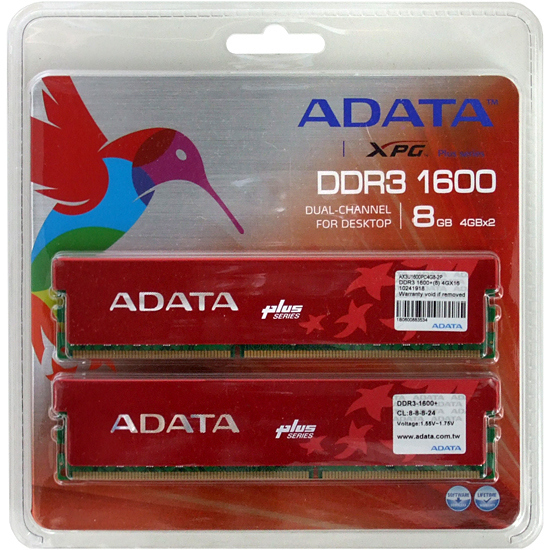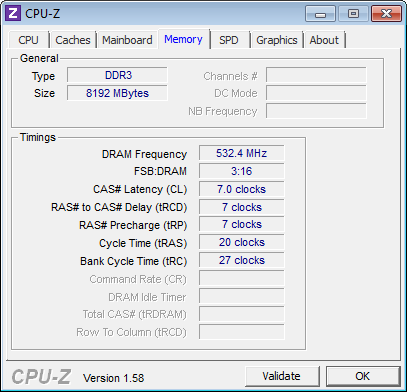Seven 8 GB DDR3 Memory Kits For Your AMD A75 Motherboard
Because integrated GPUs generally employ shared system memory, RAM performance has a significant effect on gaming frame rates. We're testing seven 8 GB DDR3 kits that manufacturers tell us are a perfect match for AMD’s mainstream Llano-based APUs.
Adata XPG DDR3-1600 CAS 8
Much of Adata's hardware shows up in Europe before it lands on our shores in North America. Although you can buy much of this company's hardware online, the kit we received for review (AX3U1600PC4G8-2P) cannot compete in today's value charts because it isn't available yet for purchase. We’re still testing it, since there's still a high probability it'll appear for sale here eventually.
European pricing would have pit these DDR3-1600 CAS 8 modules directly against the middle of today’s pack, though the 1.65-1.75 V label on the sticker exceeds the voltage range suggested by Adata's competitors. We’re going to take the conservative route today by using 1.60 V, since AMD’s 32 nm APUs haven't been around for long enough for us to give you a comfortable long-term memory controller voltage limit. Remember, we tried to be a little more aggressive when Intel's Clarkdale design emerged and started losing CPUs after a few months. The idea here is to achieve a performance level that'll stand the test of time.
Our motherboard defaults all memory to DDR3-1066, regardless of the modules' SPD values. It configured Adata’s low-latency DDR3-1600 to CAS 7.
Adata’s SPD values look only marginally better, since the CAS 8 timings are pegged to a strange DDR3-1218 data rate. The company does add XMP for the memory’s rated settings, but AMD doesn’t use this Intel-supported technology. As a result, we needed to configure this kit manually.
Adata-branded DRAM carries a lifetime warranty.
Get Tom's Hardware's best news and in-depth reviews, straight to your inbox.
Current page: Adata XPG DDR3-1600 CAS 8
Prev Page Turning DDR3 Into Graphics Memory Next Page Corsair Vengeance DDR3-1600 CAS 8-
hmp_goose Where's the CAS7 DDR3-1333? Many of us are still trying to pin down how important timing are in the scheme of things …Reply -
whysobluepandabear hmp_gooseWhere's the CAS7 DDR3-1333? Many of us are still trying to pin down how important timing are in the scheme of things …Reply
They're not.
You're better off buying value RAM with decent timings and throwing that extra $$$ into a GPU. I promise your FPS will improve more that way.
-
Crashman Reply
CAS 7? Most of the modules were tested at DDR3-1333 CAS 6.9519239 said:Where's the CAS7 DDR3-1333? Many of us are still trying to pin down how important timing are in the scheme of things …
http://www.tomshardware.com/reviews/llano-apu-memory-performance,3017-10.html
Please read the article, thanks! -
Rizlla I have been looking at those Corsair kits for an upgrade and it's good to know they are approved.Reply -
beenthere As has been known for quite some time, there is virtually no performance gain on DDR3 RAM with lower CAS because DDR3 has plenty of bandwidth and frequency. The higher the frequency the lower the cycle time in real time, thus CAS 7 vs. CAS 9 is totally insignificant in system performance.Reply -
ojas Is it a valid conclusion that, if the 8GB kits are good, then the corresponding 4GB and 2GB kits would be good to? Or will pricing make a difference there?Reply -
ChromeTusk Reply
Wish I found that Corsair CAS8 kit, but I did find the CAS9 version for $50, no rebate or shipping.9519243 said:I have been looking at those Corsair kits for an upgrade and it's good to know they are approved. -
nforce4max I bought the cheaper version G.SKill kit for $59 oh well :s can't wait for prices to drop again for a little splurge ;)Reply -
-Fran- Nice review guys!Reply
I got the HyperX modules the A8 and the Vengeance are on my main rig. Now, I'm still intrigued about unganged when using a 4 module MoBo. I got the A8 with 4 modules in unganged at 1600 CL9 and it runs pretty well, but i wonder how that compares to this 2 modules MoBo.
Cheers!



